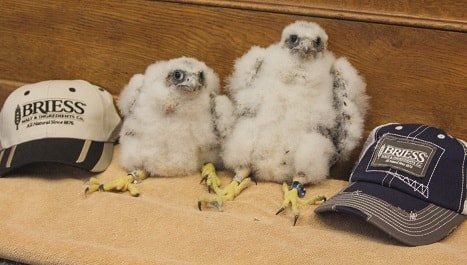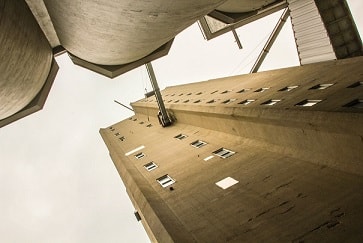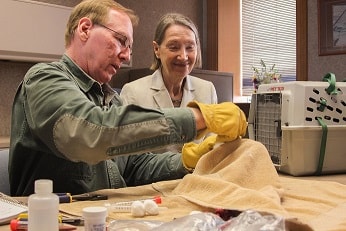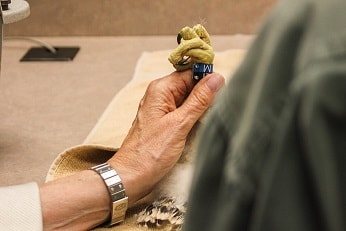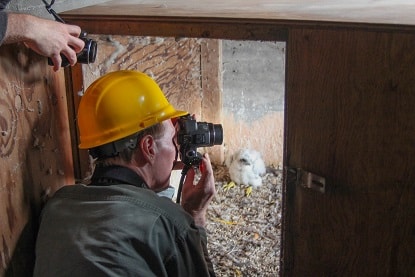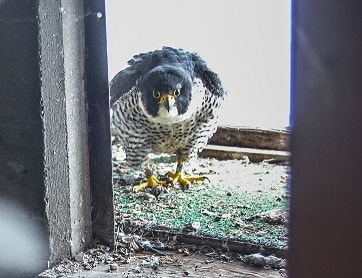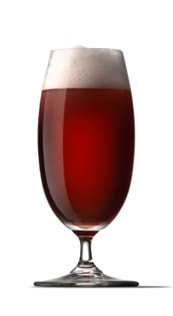This year, Monica Briess, current owner and CEO, made a special 10-hour trip to participate in the banding of our two newest members of Briess Peregrine Falcon Family. With the 2014 acquisition of the grain handling and storage operation in Manitowoc, WI, 2015 marks the second year Briess has supported a nesting pair of Peregrine Falcons.
At the top of a 12 story grain elevator, is a small nesting box where a pair of Peregrine Falcons laid five eggs, of which two hatched this spring. To research and monitor the comeback of Peregrine Falcons across Wisconsin, the eyassess are banded and blood samples are taken when they are between 20 and 24 days old.For the banding process, Greg Septon takes a small group of observers to the top of the grain elevator. The nest box is located in a safe holding area, with a small hatch door that Greg can easily access the chicks and place them into a small padded pet crate. The crate offers minimal eyelets, keeping it dark and cool, calming the young eyassess. They are then brought down the elevator into a clean office room where Greg has a station prepared to band and take blood samples.
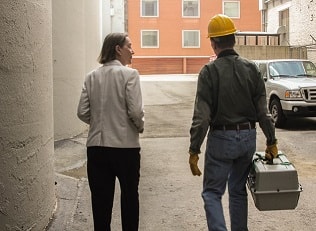
The chicks are removed from the crate one at a time and are placed on a towel on their back. Their eyes are covered to keep them calm and reduce stress. At this time, Mrs. Briess volunteers to help Greg by holding the small, but razor-sharp talons and feet of the eyasses while Greg bands them. Each band has a sequence of numbers that will identify the birds in years to come and allow the Department of Natural Resources to track their movement. The blood samples drawn are researched and archived to see which species of Peregrine Falcons the chicks derive from.
For the last 28 years Greg has directed and managed the expanding Urban Peregrine Falcon Recovery Effort in Wisconsin. In 1969, Peregrine Falcons were put on the U.S. Endangered Species list. The main cause for the population decline of these birds was due to the use of the pesticide DDT, which was banned in 1972. While the Peregrine population had been completely eradicated east of the Mississippi River by the late 1960s, today there are an estimated 1,650 breeding pairs in the U.S. and Canada.Briess is excited to be actively be a part of the Urban Peregrine Falcon Recovery Effort and is looking forward to a long lasting relationship with the falcons at the Manitowoc Facility. Mrs. Briess is also passionate about Briess’s continued conservation efforts. In a recent letter she wrote, she says:
“It’s hard to articulate the thrill of coming into such close contact with free, powerful and slightly scary hunters. The chicks look like imaginative stuffed animal until you notice their talons and beaks and listen to the squawking. That’s the reminder that they’re anything but toys; rather, they’re powerful hunters who are potentially dangerous when they’re defending themselves and their young.
“It’s an emotionally engaging experience but beyond that it’s enormously satisfying to know that we’re actively involved in conservation. It was interesting to learn that the blood drawn from the chicks’ wings goes into a DNA bank for future study. These peregrines have been reintroduced to the area after local extinction and are now dependent on the nesting sites that are provided for them. Briess has been placed in the privileged position of being able to contribute to their future in Wisconsin. We offer the gravel and the ‘cliff’ that the peregrines need and they take care of the rest.
“Even though I have supported various conservation efforts, this is very special because it feels tangible and is literally hands on. The two chicks hatched this year, ‘Bernadette’ and ‘Monica’, are a vibrant result of our conservation efforts.”

